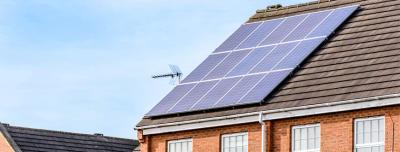Comparing Smart Export Guarantee vs Feed-in Tariff

The solar industry has been calling out for a replacement to the Feed-in Tariff (FiT) scheme since its closure in 2019. After many months of consultation, the government responded by introducing the Smart Export Guarantee to pay solar panel owners for the renewable electricity they contribute to the grid. But how does it compare to the FiT and will it be enough of an incentive for UK homeowners to embrace renewable technology?
Why has the FiT scheme been replaced by the SEG?
The FiT scheme was introduced in the UK in April 2010 to incentivise homeowners and businesses to invest in renewable energy. It obliged energy suppliers to pay owners of renewable energy generation systems for the electricity they generated and contributed to the National Grid. The scheme was very successful and more people than anticipated installed solar panels and benefited from the FiT scheme.
However, this meant that the government reduced the tariff being offered over 9 years before finally closing it to new applicants in March 2019. The Smart Export Guarantee scheme has been brought in to replace the FiT scheme, to encourage the UK to invest in renewable technology and reduce our carbon emissions as we work towards achieving net zero carbon emissions by 2050.
There are some key differences between the FiT and the SEG…
How does the SEG compare to the FiT?
If you are already receiving FiT payments for your solar panels, you will continue to do so for 20-25 years after you joined the scheme. The SEG does not change anything for existing FiT recipients, but as the FiT scheme closed to new applicants in March 2019, the SEG is aimed at new solar panel owners. Here are the key differences between the schemes.
| Feed-in Tariff | Smart Export Guarantee | |
| Payment tariffs | Same tariff for all applicants, regardless of electricity supplier, set by Ofgem. | Different tariffs depending on which electricity supplier you choose. |
| Fixed tariff? | Tariff received fixed for 20-25 years after installation. | Suppliers can change tariff and offer multiple options such as fixed or flexible. |
| Electricity bought under the scheme | Two payments: generated electricity and estimated exported electricity. | A single payment for exported electricity only. |
| How payments are calculated | Generated electricity is metered but exported electricity usually estimated at 50% of generation. | Exported electricity metered by a smart meter capable of 30 minute readings. |
| Solar panel certification required | MCS certification required | MCS or equivalent, e.g. Flexi-Orb |
| Funding for the scheme | The FIT was paid for by a levy on all customers' energy bills. | The SEG is paid by energy companies who buy the power. |
How much could you earn through the FiT vs the SEG scheme?
If you are receiving FiT payments, the amount you are earning will vary depending on when you installed your solar panels. When the FiT scheme was first introduced in April 2010 solar panel owners were receiving over 40p per kWh of electricity. This tariff was reduced on a quarterly basis until, in March 2019 when the scheme closed, applicants received less than 4p for generated electricity and just over 5p for exported electricity.
The SEG scheme does not have a universal payment amount other than to stipulate it must be above zero at all times. While only a few electricity suppliers have released information about their SEG tariffs, those which have been published are set between 5-6p. Find out more about the tariffs which are available here.
Should you switch from FiT to SEG?
It is possible to switch from the FiT scheme to the SEG, however...
Solar panel owners who are already taking part in the FiT scheme will be receiving in excess of 5p per kWh of exported electricity and, unlike people on the SEG scheme, will also be paid for their generated electricity.
The SEG scheme payments do not include generated electricity and the exported payments are unlikely to exceed FiT tariff payments by a significant amount. In addition, your FiT payments are guaranteed for the remainder of the 20-25 year period you signed up for originally. Because the FiT export payments were estimated at 50% of generation rather than metered, if you used more than 50% of your generated electricity you would be better off.
Switching to the SEG would not only mean that you would receive lower payments in most cases, but they would also not be guaranteed as suppliers can change their tariffs and offer as little as 0.01p if they choose to.
Applying for the SEG scheme
The SEG scheme is available to owners of renewable energy generation systems including solar photovoltaic (solar PV) panels, wind, micro combined heat and power (CHP), hydro and anaerobic digestion (AD). The installation must have a capacity of 5MW or less, a meter capable of providing half-hourly export readings and it must be certified by the MCS or an equivalent scheme. This means that both the installer who fits the solar panels and the panels themselves have been approved by the microgeneration certification scheme (MCS) or a recognised equivalent like Flexi-Orb. The meter will need to be advanced, e.g. a second-generation smart meter, to be able to provide the required readings.
The SEG scheme is accepting applications from 1st January 2020. If you have installed solar panels since the FiT scheme closed on 31st March 2019, you can still apply for the scheme when it opens but won't be able to claim back-payments.
To apply for the SEG scheme you will need to apply to a SEG Licensed energy supplier. Your SEG licensee does not need to be the same company as your energy supplier so you can shop around to find the best tariff.
Why buy solar panels?
Solar panels are cheaper than ever before to install with full systems available for £5,000-£8,000, depending on the size of the system you install. In addition to earning money through the SEG scheme there are several big benefits of installing solar panels to consider:
Get free solar panel quotes today
If you are interested in reducing your electricity bills, earning money through the SEG scheme and joining the fight against climate change, get quotes for solar PV panels today.
All you need to do is complete our quick enquiry form and can get up to 4 free quotes from MCS certified (or equivalent) solar panel installers in your area. We'll find you competitive quotes to compare today. It's quick, free and there's no obligation to use any quotes you receive.
We only work with reputable MCS certified (or equivalent) companies which have passed our strict quality criteria, so you can rest assured you'll receive only the very best service.
Find local, MSC certified Solar Installers
Start your quote
Find local, MSC certified Solar Installers














